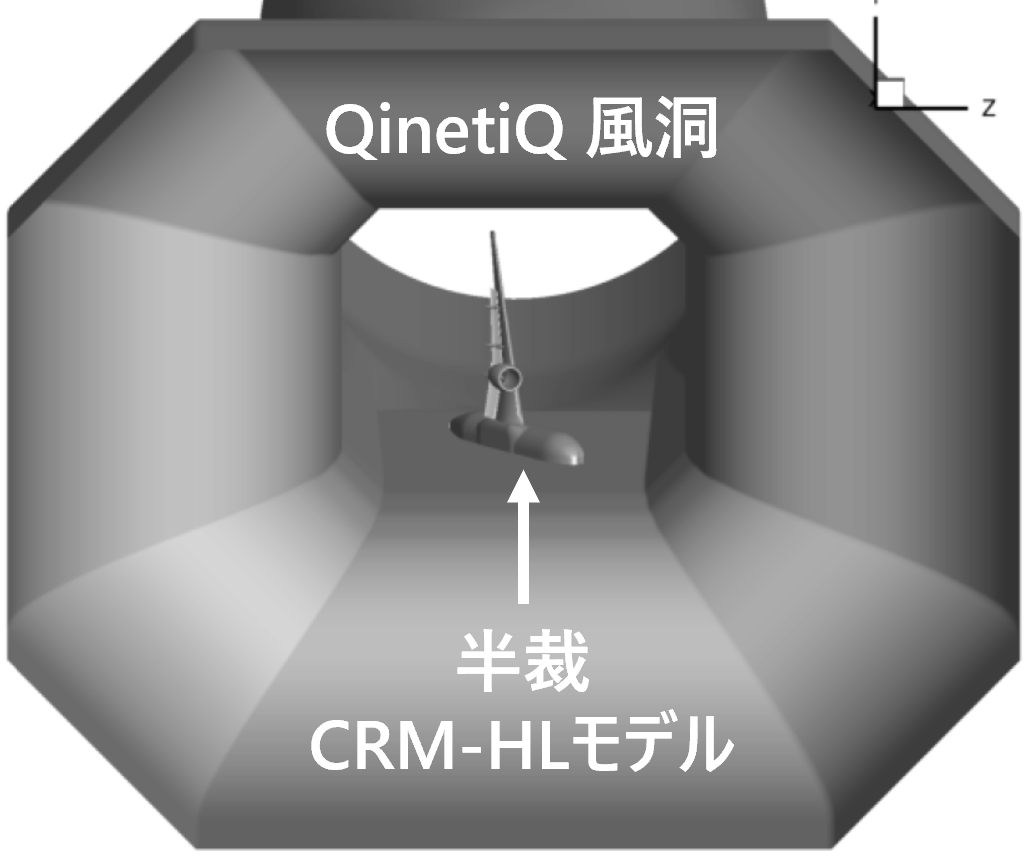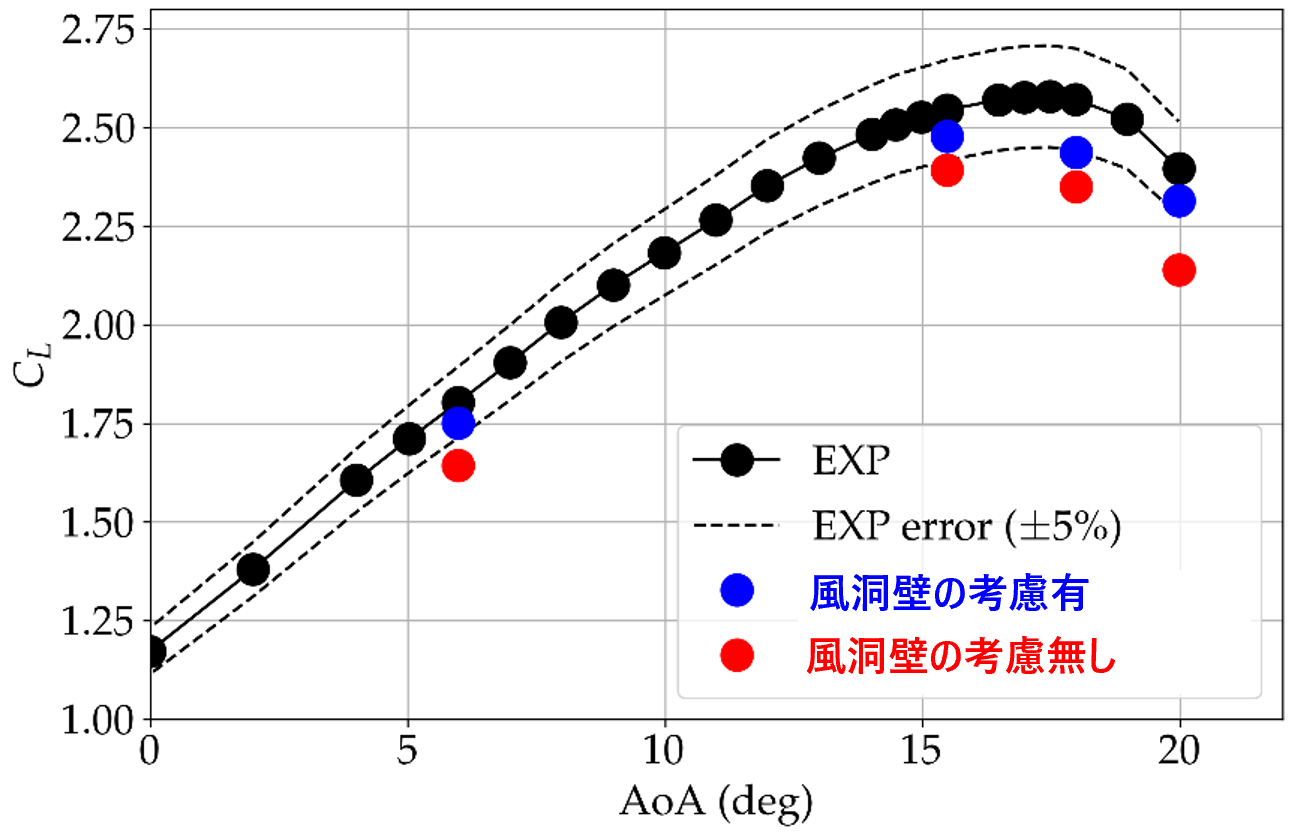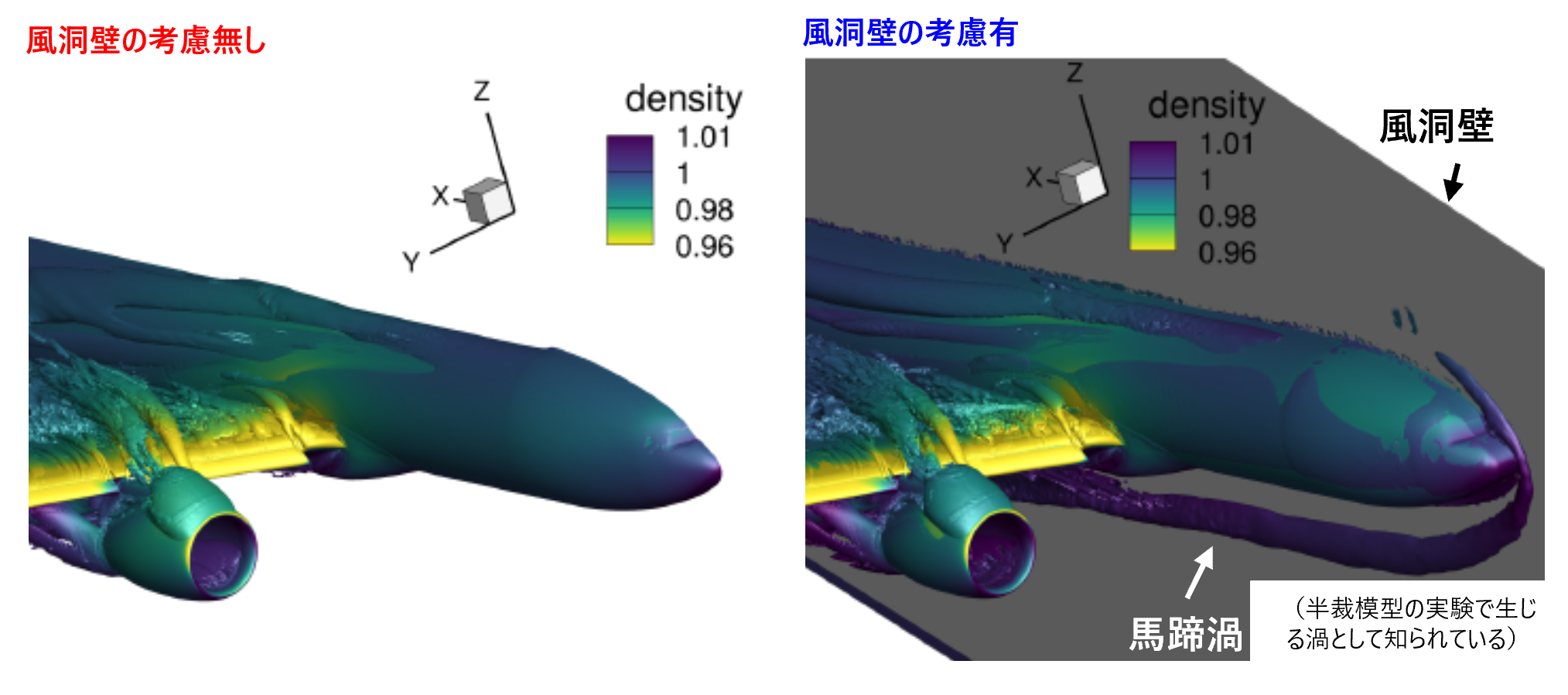Numerical analyses for CFD workshops
JAXA Supercomputer System Annual Report February 2024-January 2025
Report Number: R24EDA201G27
Subject Category: Aeronautical Technology
- Responsible Representative: Kazuyuki Nakakita, Aviation Technology Department
- Contact Information: Andrea Sansica(sansica.andrea@jaxa.jp)
- Members: David Lusher, Kenji Hayashi, Tomoaki Matsuzaki, Yoimi Kojima, Andrea Sansica
Abstract
Using JAXA's FaSTAR-DDES tool, we verified stall predictions for the CRM-HL aircraft shape, taking into account the effects of the wind tunnel walls. As experimental data for comparison, we used wind test data for a simulated shape (CRM-HL with nacelle) from the UK's QinetiQ wind tunnel, which was made public for verification at AIAA High-Lift Prediction Workshop 4, and performed an analysis that included not only the model but also the wind tunnel test section for high-precision verification that took into account the effects of the wind tunnel walls (Figure 1).
Reference URL
N/A
Reasons and benefits of using JAXA Supercomputer System
For CFD workshops, it is necessary to use JAXA's supercomputers to perform a large number of calculations of three-dimensional complex shapes to achieve high accuracy.
Achievements of the Year
By considering the effects of the wind tunnel walls, we succeeded in predicting the CL characteristics at low angles of attack and near CLmax to within 5% of the experimental values (Figure 2):
- If the effects of the wind tunnel walls are not considered, the difference between the experiment and CFD is up to 10% (Figure 2 red)
- By considering the effects of the wind tunnel walls, the difference between the experiment and CFD is improved to a maximum of 5% (Figure 2 blue)
The analysis using FaSTAR-DDES revealed that the wind tunnel walls induce horseshoe vortices (known as vortices that occur in half-cut model experiments) and that it is essential to capture the effects of these vortices in order to compare with the experiment (Figure 3).
Publications
- Peer-reviewed papers
M. Zauner, A. Sansica, T. Matsuzaki, D. J. Lusher, A. Hashimoto, Free-Air Simulation Sensitivities on NASA's High-Lift Common Research Model, AIAA Journal (2024). doi:10.2514/1.J064511
- Non peer-reviewed papers
[1] Sansica A., Hashimoto A., Ishida T., Hayashi K., Matsuzaki T., A Look Back to Past APC Editions: Successes, Unresolved Challenges and Future Directions, APC-9 Special Follow-up Session, 56th Fluid Mechanics Symposium/42nd ANSS, Kagoshima (2024)
[2] Zauner M., Sansica A., Hashimoto A., Adaptive Mesh Refinement of NASA's High-Lift Configuration of the Common Research Model, APC-9 Special Follow-up Session, 56th Fluid Mechanics Symposium/42nd ANSS, Kagoshima (2024)
[3] Sansica A., Lusher D., Hayashi K., Matsuzaki T., JAXA's contribution to the 5th AIAA CFD High Lift Prediction Workshop, 5th AIAA CFD High Lift Prediction Workshop (HLPW-5), AIAA Aviation Forum, Las Vegas (2024)
- Oral Presentations
[1] Sansica A., Hashimoto A., Ishida T., Hayashi K., Matsuzaki T., A Look Back to Past APC Editions: Successes, Unresolved Challenges and Future Directions, APC-9 Special Follow-up Session, 56th Fluid Mechanics Symposium/42nd ANSS, Kagoshima (2024)
[2] Zauner M., Sansica A., Hashimoto A., Adaptive Mesh Refinement of NASA's High-Lift Configuration of the Common Research Model, APC-9 Special Follow-up Session, 56th Fluid Mechanics Symposium/42nd ANSS, Kagoshima (2024)
Usage of JSS
Computational Information
- Process Parallelization Methods: MPI
- Thread Parallelization Methods: N/A
- Number of Processes: 480 - 2304
- Elapsed Time per Case: 200 Hour(s)
JSS3 Resources Used
Fraction of Usage in Total Resources*1(%): 0.98
Details
Please refer to System Configuration of JSS3 for the system configuration and major specifications of JSS3.
| System Name | CPU Resources Used(Core x Hours) | Fraction of Usage*2(%) |
|---|---|---|
| TOKI-SORA | 24257158.01 | 1.11 |
| TOKI-ST | 556802.68 | 0.57 |
| TOKI-GP | 0.00 | 0.00 |
| TOKI-XM | 0.00 | 0.00 |
| TOKI-LM | 16809.94 | 1.21 |
| TOKI-TST | 9.03 | 0.00 |
| TOKI-TGP | 0.00 | 0.00 |
| TOKI-TLM | 0.00 | 0.00 |
| File System Name | Storage Assigned(GiB) | Fraction of Usage*2(%) |
|---|---|---|
| /home | 1445.92 | 0.98 |
| /data and /data2 | 149664.48 | 0.72 |
| /ssd | 34743.97 | 1.86 |
| Archiver Name | Storage Used(TiB) | Fraction of Usage*2(%) |
|---|---|---|
| J-SPACE | 21.27 | 0.07 |
*1: Fraction of Usage in Total Resources: Weighted average of three resource types (Computing, File System, and Archiver).
*2: Fraction of Usage:Percentage of usage relative to each resource used in one year.
ISV Software Licenses Used
| ISV Software Licenses Used(Hours) | Fraction of Usage*2(%) | |
|---|---|---|
| ISV Software Licenses(Total) | 1645.84 | 1.12 |
*2: Fraction of Usage:Percentage of usage relative to each resource used in one year.
JAXA Supercomputer System Annual Report February 2024-January 2025





